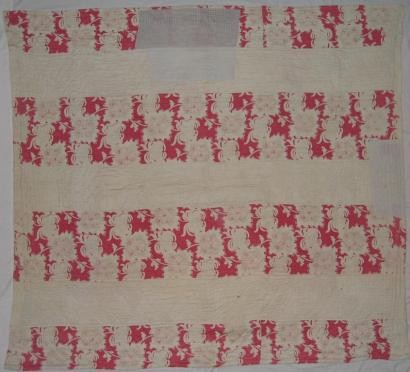2002-18-F red floral and white strippy

This strippy quilt (1990 x 1845mm) was made by Sarah Ann Davies (1862 – 1944), who was born in Pontrhydyfen in Neath Port Talbot, West Glamorgan, South Wales. Her mother died of tuberculosis when Sarah was two years old and she was lovingly raised by her step-mother. Poverty decreed that she left home at about ten years of age to become a dairymaid at Llangyfelach and later at Castell Nedd. On her rare days off she would return home exhausted. Her step-mother would greet her lovingly but having sat her near the fire and provided a cup of hot tea she would be handed a half knitted stocking or a piece of sewing to be getting on with. “Every stitch you do now, won’t have to be worked again,” – her step-mother would say.
Sarah Ann married David Davies in Aberdare and began sewing quilts for her own rapidly growing family. David, a gentle scholarly man, worked as a collier until, wearying of the continual industrial unrest in that area, the family moved from Aberdare to Abertridwr where he found work at the Windsor Colliery. In all Sarah bore eight children several of whom died in infancy. Throughout her life she battled hard against the crippling poverty that was her lot. Standards were upheld – the house sparkled, not a penny was wasted and every scrap of everything was put to good use.
Sarah made many quilts from “recycled” fabrics and pattern books from drapers’ shops in Abertridwr. As her daughters grew, Sarah taught them the craft of patch working. Her daughter Eunice recalled as a child being taught to sew the patches together and, when the faces were complete, the quilting frame being brought down from behind the horsehair sofa for the quilting process to begin.
The Quilt Association has several of Sarah’s quilts in its collection. They are “pattern books” in themselves and much may be learned of Valley life in the first quarter of the century by studying them.